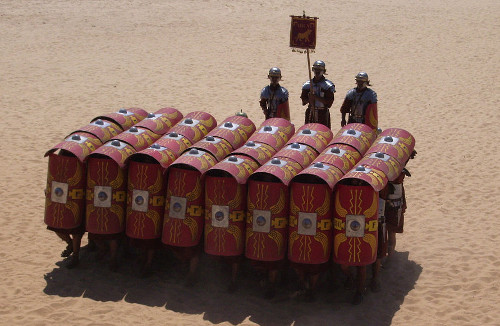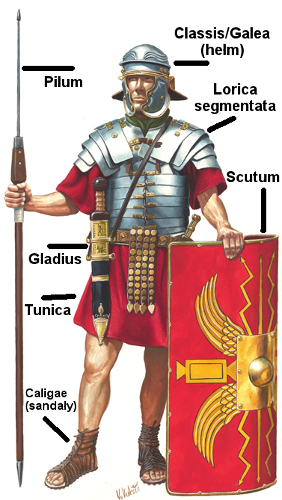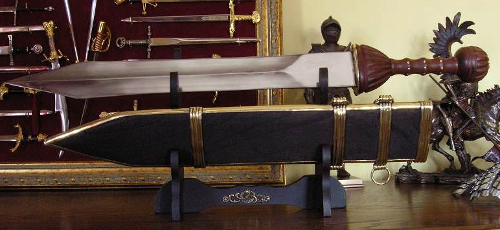
Pic. 1. Testudo (formation) - commonly known as turtle.
Since the very beginning, the army of ancient Rome was undergoing numerous changes. When the Roman state was founded, the troops consisted of the wealthiest citizens only. Later the situation was reversed, as it was the poorest strata of society who dominated the military force. It took its final form in the second century BC, when the professional army was established. Since then, a military service was one of the available professions.
A Roman legionary (Legionarius) had a hard life, as his job entailed unprecedented physical and mental strength. Volunteers or conscripts were not sure whether after 16 years of military service they return to their homes (in 5 AD, this period increased up to 20 years). The beginners had very difficult responsibilities, because absolute discipline was applied, so that they would become real men, ready to win a combat with any, even the overwhelming enemy..
When the reform of Marius was introduced, the military age was set at 17-20 years and the service in the army lasted 16 years. The huge drawback of the Roman legionaries was their height, as it averaged only about 168 cm. The scientific explanation of the Romans' shortness lies in their diet, which consisted largely of flour products, while the barbarians ate large quantities of meat, rich in proteins. Geoffrey Kron confirmed the average height of Romans, thanks to his research carried out on 927 skeletons of adult men from the period between 500 BC and 500 AD, discovered in Italy. Most probably, the Roman soldiers were selected due to their height, as their important task was to maintain an adequate formation (such as Testudo).
Although the opponents of the Romans were much taller (e.g. The Gauls and Germans measured an average of 170-185 cm), legionaries were ahead of them in terms of military skills. Their main strengths were their ability to work in team and fight in all weather conditions, hard discipline, superior equipment, great training and impressive stamina. Daily military drill and a demanding training provided them with the ability to walk as far as 37.5 km a day, carrying loads of up to 36 kg on their backs.

Pic. 2. Pilum - spear of the Roman legionary
Such a long march with full equipment was one of the basic skills which had to be acquired by every recruit. Moreover, half of this distance had to be run. Next, a recruit learnt how to build a camp and was obliged to perform special military exercises twice a day, while experienced legionaries did it only once a day. He learnt to throw stones, swim and ride a horse. He had to know how to jump on and off both sides of his horse while running in complete armour. It was an extremely difficult task, bearing in mind that stirrups were not invented yet. However, the greatest importance was attached to the training of weapons' usage.
A soldier was equipped with a wicker shield and a blunt wooden sword (rudis), which had a weight similar to the real weapons and sometimes even bigger. A recruit had to attack a grounded stake presenting a human height and in this way, acquire the ability to effectively hit an enemy. His duties included also a training of throwing an extremely heavy pilum. Battle simulations were sometimes organized, in which the blades were secured with covers to avoid any possible injuries.

Pic. 3. Legionnaire and its equipment
Comparing the Roman soldier from the initial period of the Republic with a legionary from the second century AD for instance, we notice many differences. They concern mainly the quality and style of the armament. However, some consistent basic elements can be distinguished:
The literal meaning of the Latin word “gladius” is “a sword”. This name probably derives from gladiators who used this weapon in their fights. At the beginning of the republic, Roman soldiers used Greek swords. Later, they adopted Spanish swords from the Celtiberians. The full name of the Roman sword was Gladius Hispaniensis.
This weapon was widely used by legionaries both at the time of the republic and in the Empire (third century BC - third century AD). Then, gladius was replaced with its elongated form called spatha, which was included to the basic cavalry armament. Gladius was probably taken over from the Celts and Iberians during the Punic Wars. Before the Second Punic War, the so-called Gallic type of a sword was used. Then, it was displaced by a shorter sword of the Spanish type. Later, during the Empire era, spatha started to be most widely used. Moreover, all the legionaries held a short dagger (pugio) behind their belts.

Pic 4. Richly engraved Gladius with scabbard - a sword replica
Gladius was used both for thrusting and cutting, but the first technique was more common. Thanks to the right length and a well-developed blade, it was possible to maneuver the sword efficiently and quite easily, what enabled a soldier to thrust an opponent precisely.
Gladius underwent some structural changes, as the technique and the art of warfare developed. It mainly concerns the blade, which initially measured 75 to 85 cm and eventually obtained a length of 80-100 cm. The iron blade had a clearly delineated, tapered point, perfect for stabbing. The hilt had a spherical pommel made of wood or a horn. Its core was captured with oval rings or notched and endowed with a not too prominent, boxy guard. The hilt was profusely decorated, sometimes even with silver or gold, especially when it comes to the weapons owned by the highest officers. Gladius was worn on the right hand side, in a metal-covered sheath (vagina) slung over the left shoulder. The belt, that the Roman sword was strapped to, was named balteus.
Between the third and fourth century AD, the Roman border units significantly transformed, what fundamentally changed the appearance and quality of the Roman imperial army. Horses started to be more widely used in battle, in order to face the enemies more effectively and to prevent the attacks of the Barbarians. The German and Eastern weapons, armours and tactics began to be more popular, as many foreign soldiers joined the Roman army.
The changes in armour and weaponry are the main evidence of the Roman army barbarisation process. Pilum and gladius were replaced with a Germanic spear and spatha. It was a long, straight sword with a double-edged blade, adapted both by infantry and cavalry. The sharpened spatha was made for stabbing, but usually it was used for cutting, what was a direct imitation of the tactics preferred by the Germanic tribes. It was heavier than gladius and had a medium-size sword hilt. Its guard was straight and massive, with a pommel resembling a minimized form of it.
Spatha performed more effectively in looser battles and in cavalry, as gladius was designed primarily for pedestrian tight formation under the cover of scutum (a large shield). At the beginning of the fourth century, the Roman infantry almost entirely ceased to use a body armour. A Roman soldier protected himself with a circular or elliptical shield, based on the Germanic prototypes, which entirely displaced the rectangular scutum. The Germanic practices were applied in heavy cavalry as well, as it was equipped with metal helmets and chain mails.
The barbarisation of the Roman army was not all to the good. The quality of weapons was significantly lower, and the degree of training got worse in comparison with the previous standards. Thus, the legion known from the period of the late republic and the principate ceased to exist with the beginning of the fourth century AD.

Pic 5. Banner aquila always wielded by aquilifer (senior warrant officer carrying the symbol of the Roman legion).
In our shop, you will find the best-quality weapons' replica only. We provide you with a closely copied Roman sword gladius, with or without a sheath. The replica of a sword used by the officers arouses the strongest admiration, along with its luxuriantly decorated sheath. We also stock models used by gladiators, as well as pilum. Moreover, we recommend the beautiful racks, belts or hangers which can be found in the appropriate store departments. Apart from a sword replica, you can purchase also the copies of Roman chain mails, helmets and segmented armours made of natural leather or steel, coming from various periods of the Empire.